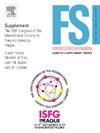自称为厄瓜多尔土著人民的父系遗产
IF 0.5
Q4 GENETICS & HEREDITY
Forensic Science International: Genetics Supplement Series
Pub Date : 2022-12-01
DOI:10.1016/j.fsigss.2022.10.033
引用次数: 0
摘要
本研究旨在描述厄瓜多尔土著人口的父系遗传组成。为了研究可能的消光偏差,还分析了AIM InDels。54名厄瓜多尔土著居民的人口样本具有高度的单倍型多样性。大部分雄性谱系属于美洲原住民单倍群。尽管来自自称的土著人,但所研究的人口样本与厄瓜多尔的混合个体样本的遗传距离较低。本文章由计算机程序翻译,如有差异,请以英文原文为准。
The paternal heritage of self-declared Ecuadorian indigenous people
The present study aimed to characterize the paternal genetic composition of the Ecuadorian indigenous population. To investigate a possible matting bias, AIM-InDels were also analyzed. The population sample of 54 self-declared Ecuadorian indigenous presented a high haplotype diversity. A major proportion of the male lineages belong to Native American haplogroups. Although from self-declared indigenous, the studied population sample presented a low genetic distance with a sample of admixed individuals from Ecuador.
求助全文
通过发布文献求助,成功后即可免费获取论文全文。
去求助
来源期刊

Forensic Science International: Genetics Supplement Series
Medicine-Pathology and Forensic Medicine
CiteScore
0.40
自引率
0.00%
发文量
122
审稿时长
25 days
期刊介绍:
The Journal of Forensic Science International Genetics Supplement Series is the perfect publication vehicle for the proceedings of a scientific symposium, commissioned thematic issues, or for disseminating a selection of invited articles. The Forensic Science International Genetics Supplement Series is part of a duo of publications on forensic genetics, published by Elsevier on behalf of the International Society for Forensic Genetics.
 求助内容:
求助内容: 应助结果提醒方式:
应助结果提醒方式:


